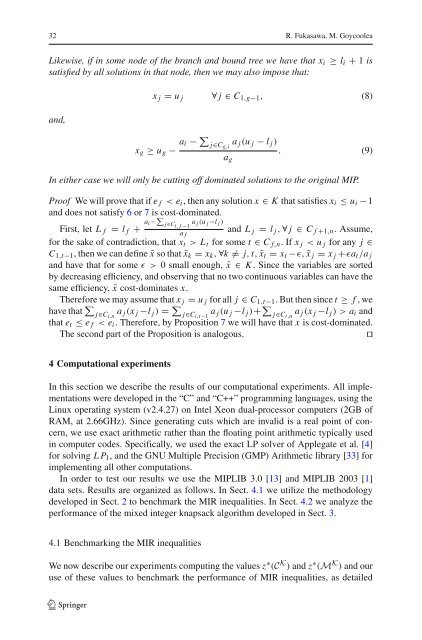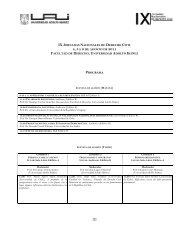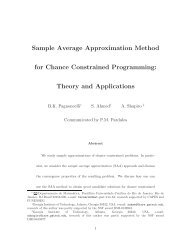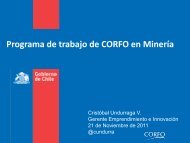On the exact separation of mixed integer knapsack cuts - Marcos ...
On the exact separation of mixed integer knapsack cuts - Marcos ...
On the exact separation of mixed integer knapsack cuts - Marcos ...
Create successful ePaper yourself
Turn your PDF publications into a flip-book with our unique Google optimized e-Paper software.
32 R. Fukasawa, M. GoycooleaLikewise, if in some node <strong>of</strong> <strong>the</strong> branch and bound tree we have that x i ≥ l i + 1 issatisfied by all solutions in that node, <strong>the</strong>n we may also impose that:and,x j = u j ∀ j ∈ C 1,g−1 , (8)x g ≥ u g − a i − ∑ j∈C g,ia j (u j − l j )a g. (9)In ei<strong>the</strong>r case we will only be cutting <strong>of</strong>f dominated solutions to <strong>the</strong> original MIP.Pro<strong>of</strong> We will prove that if e f < e i , <strong>the</strong>n any solution x ∈ K that satisfies x i ≤ u i −1and does not satisfy 6 or 7 is cost-dominated.First, let L f = l f + a i − ∑ j∈C a i, f −1 j (u j −l j )a fand L j = l j , ∀ j ∈ C f +1,n . Assume,for <strong>the</strong> sake <strong>of</strong> contradiction, that x t > L t for some t ∈ C f,n .Ifx j < u j for any j ∈C 1,t−1 , <strong>the</strong>n we can define ¯x so that ¯x k = x k , ∀k ̸= j, t, ¯x t = x t −ɛ, ¯x j = x j +ɛa t /a jand have that for some ɛ>0 small enough, ¯x ∈ K . Since <strong>the</strong> variables are sortedby decreasing efficiency, and observing that no two continuous variables can have <strong>the</strong>same efficiency, ¯x cost-dominates x.Therefore we may assume that x j = u j for all j ∈ C 1,t−1 . But <strong>the</strong>n since t ≥ f ,wehave that ∑ j∈C i,na j (x j −l j ) = ∑ j∈C i,t−1a j (u j −l j )+ ∑ j∈C t,na j (x j −l j )>a i andthat e t ≤ e f < e i . Therefore, by Proposition 7 we will have that x is cost-dominated.The second part <strong>of</strong> <strong>the</strong> Proposition is analogous.⊓⊔4 Computational experimentsIn this section we describe <strong>the</strong> results <strong>of</strong> our computational experiments. All implementationswere developed in <strong>the</strong> “C” and “C++” programming languages, using <strong>the</strong>Linux operating system (v2.4.27) on Intel Xeon dual-processor computers (2GB <strong>of</strong>RAM, at 2.66GHz). Since generating <strong>cuts</strong> which are invalid is a real point <strong>of</strong> concern,we use <strong>exact</strong> arithmetic ra<strong>the</strong>r than <strong>the</strong> floating point arithmetic typically usedin computer codes. Specifically, we used <strong>the</strong> <strong>exact</strong> LP solver <strong>of</strong> Applegate et al. [4]for solving LP 1 , and <strong>the</strong> GNU Multiple Precision (GMP) Arithmetic library [33] forimplementing all o<strong>the</strong>r computations.In order to test our results we use <strong>the</strong> MIPLIB 3.0 [13] and MIPLIB 2003 [1]data sets. Results are organized as follows. In Sect. 4.1 we utilize <strong>the</strong> methodologydeveloped in Sect. 2 to benchmark <strong>the</strong> MIR inequalities. In Sect. 4.2 we analyze <strong>the</strong>performance <strong>of</strong> <strong>the</strong> <strong>mixed</strong> <strong>integer</strong> <strong>knapsack</strong> algorithm developed in Sect. 3.4.1 Benchmarking <strong>the</strong> MIR inequalitiesWe now describe our experiments computing <strong>the</strong> values z ∗ (C K ) and z ∗ (M K ) and ouruse <strong>of</strong> <strong>the</strong>se values to benchmark <strong>the</strong> performance <strong>of</strong> MIR inequalities, as detailed123
















